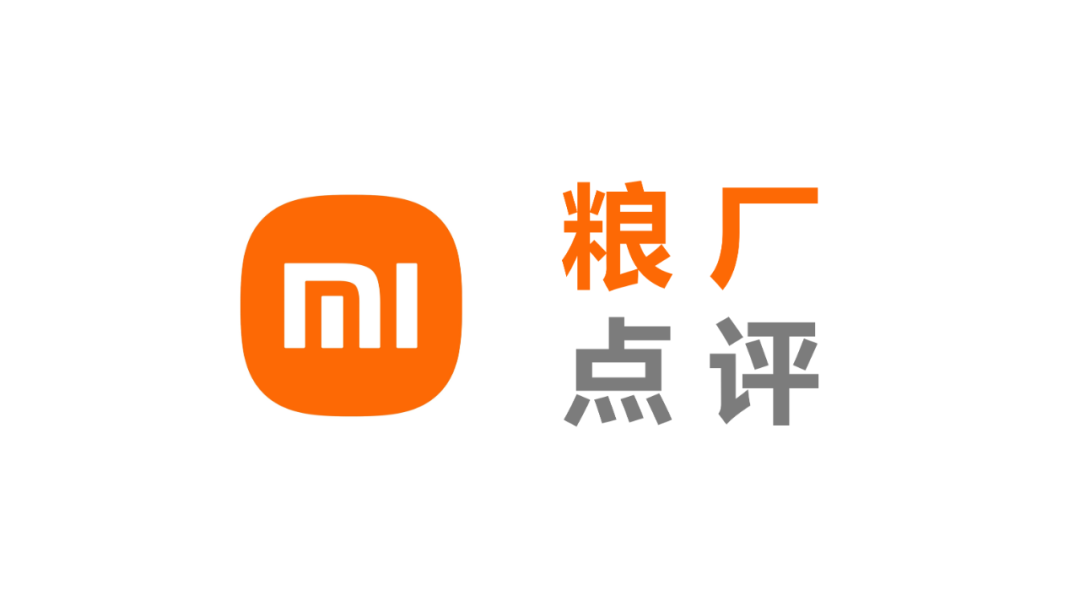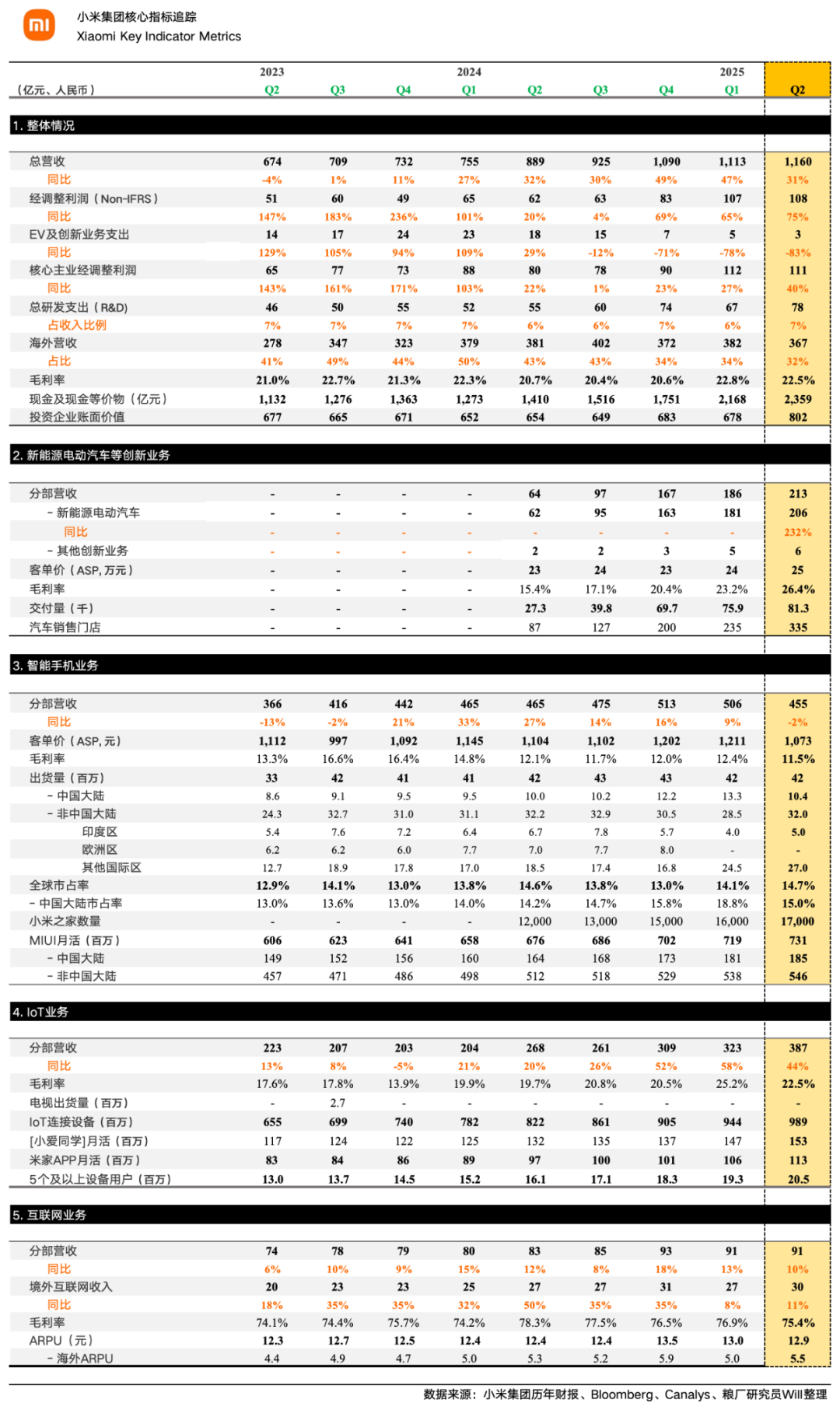粮厂研究员Will | 小米集团2025年Q2财报点评 — 先放下答案,再学会提问

“粮厂点评”频道致力于点评粮厂的季度财报、产品发布会、市场表现或其他重大事件,不追求信息即时性和效率性,主要为读者提供粮厂研究员的观点。
8月19日收市后,小米集团2025年2季度财报如约公布:
Today, Xiaomi Corp. released its Q2 2025 results as scheduled:
- 2025年Q2,小米集团总营收录得1,160亿元,同比上涨31%,经调整利润108亿元,同比上涨75%,均为历史新高;其中核心业务利润为111亿元,对应造车和创新业务相关亏损为3亿元;集团整体毛利率继续超过20%,达到历史新高的22.5%。
In Q2 2025, Xiaomi achieved record-high revenue of RMB 116.0 billion, up 31% yoy, and record-high adjusted net profit of RMB 10.8 billion, up 75%. Core-business profit reached RMB 11.1 billion, offset by a RMB 0.3 billion loss from EV and other innovation initiatives. Group-level gross margin set a new record at 22.5%, remaining above 20%.
- 2025年Q2,智能电动汽车及创新业务营收录得213亿元;交付8.1万台,毛利率持续爬升至26.4%,ASP为25.3万元。
EV and innovation businesses generated RMB 21.3 billion in revenue for Q2 2025. The company delivered 81,000 vehicles, improved gross margin to 26.4%, and achieved an average selling price (ASP) of RMB 253,000 per unit.
- 2025年Q2,智能手机业务营收录得455亿元人民币,同比下降2%;全球出货量4,240万台,全球市占率14.7%;毛利率为11.5%,ASP为1,073元人民币。中国区线下新零售门店数量持续增加,超过17,000家。
Smartphone revenue totaled RMB 45.5 billion, down 2% YoY. Global shipments reached 42.4 million units, securing a 14.7% worldwide market share. Gross margin was 11.5% with an ASP of RMB 1,073. Offline new-retail stores in China continued expanding, exceeding 17,000 locations.
- 2025年Q2,IoT业务营收录得387亿元人民币,同比增长44%;毛利率为22.5%,较2025年一季度的25.2%略微下滑;其中智能大家电品类收入创历史新高,同比增长66%。
IoT revenue surged 44% YoY to RMB 38.7 billion, with a gross margin of 22.5%—slightly below Q1 2025's 25.2%. Smart large-home-appliance revenue reached an all-time quarterly high, growing 66% YoY.
- 2025年Q2,互联网业务营收录得91亿元人民币,同比增长10%,整体毛利率为75.4%。海外互联网收入达到30亿元,环比增长11%。
Internet services revenue grew 10% YoY to RMB 9.1 billion, maintaining a robust gross margin of 75.4%. Overseas internet revenue reached RMB 3.0 billion, increasing 11% quarter-on-quarter.
其实从小米集团近期的股价表现,不难看出资本市场早在8月上旬已经开始交易二季报的业绩。8月初多家投行和券商下修了小米Q2的财报模型和预测,股价随之从55港币区间走弱至50港币,直至近期市场beta回暖,股价才得到初步支撑。
Xiaomi's recent share-price movement clearly indicates that the capital market began pricing in second-quarter earnings as early as early August. After several investment banks and brokers downgraded their Q2 forecasts at the beginning of the month, the stock dropped from around HK$55 to HK$50, only finding temporary support when the broader market rebounded in recent days.
我这两周也同超过50位机构和个人投资者进行了交流,听到了不同版本的对小米基本面的担忧(或者说看空逻辑)。虽然有很多版本,但主线逻辑是相若的 —— 「小米在短期没有催化剂的情况下,基本面边际有走弱的趋势。」
In the past two weeks, I've spoken with over 50 institutional and retail investors and heard various concerns about Xiaomi's fundamentals. Despite differing narratives, the core argument remains consistent: "With no near-term catalysts, Xiaomi's fundamentals show signs of marginal deterioration."
「短期没有催化剂」指的是小米在6月26日发布完第二款车YU7并取得现象级成功后,短期看不到同级别的资本市场催化剂。所以,对比恒生科技指数,在YU7发布前小米显著跑赢,而在发布后逐渐跑输。结合港股通持股比例下降来看,资金有利好兑现离场的趋势。
"No near-term catalysts" refers to the absence of significant market-moving events following the June 26 launch of the YU7, Xiaomi's second vehicle, which generated tremendous excitement. Before the YU7 debut, Xiaomi significantly outperformed HS TECH; since then, it has gradually underperformed. The concurrent decline in south-bound Stock Connect ownership suggests investors were taking profit on the positive news.
「基本面边际走弱」指的是经营和财务指标有同比或者环比走弱的情况。具体而言有两点:
"Marginal deterioration in fundamentals" points to observable weaknesses in operating and financial metrics. Two key issues stand out:
(1)Q2的经调整利润(包括反算汽车及创新业务的亏损)弱于预期。在Q1取得历史新高业绩 —— 营收1,113亿元 / 利润112亿元 —— 之后,资本市场对于小米Q2的业绩预期给得比较满。例如,在8月初的券商模型更新之前,很多卖方分析师都预测本季经调整利润会超过Q1,来到120-130亿元区间。
(1) Q2 adjusted net profit (including the loss from EV and other innovation businesses) will likely miss expectations. Following the record Q1 performance—RMB 111.3 billion in revenue and RMB 11.2 billion in profit—consensus expectations were high. Before the early-August forecast cuts, many sell-side analysts anticipated adjusted profits exceeding Q1, in the RMB 12–13 billion range.
(2)智能手机和IoT大家电业务因为BOM成本上涨和竞争激烈,分部业务毛利率承压。Q2智能手机毛利率为11.5%,IoT业务毛利率为22%,环比Q1的12.4%和25.2%都出现下滑。因此,智能手机在国补退坡和以存储为代表的BOM成本上升的背景下,毛利率会进一步下滑;而以空调为代表的大家电业务,也因为前期过于亮眼的表现,有被其他巨头贴身搏斗的可能,从而恶化竞争格局。
(2) Both smartphone and large-home-appliance IoT segments face gross-margin pressure from rising BOM costs and intensifying competition. Q2 smartphone GPM reached 11.5% and IoT GPM 22%, down from 12.4% and 25.2% respectively in Q1. With national subsidies declining and memory prices increasing, smartphone margins are expected to compress further. Meanwhile, the impressive performance of air-conditioners has attracted competitors, intensifying market competition.
在和投资人的交流中,我无意反驳他们上述的看空逻辑;因为一家被赋予了高PE倍数的万亿级公司,自然需要承担资本市场投射的高预期。
In my conversations with investors, I never set out to refute the bearish arguments above. A trillion-dollar company carrying a high P/E multiple must, by definition, bear the weight of lofty expectations that the market has projected onto it.
我回应的角度,是建议投资者(当然,主要是长期持股的价值投资者)增加一些视角去看待小米的基本面:
Instead, my response has been to invite investors—especially the long-term, value-oriented ones—to adopt additional perspectives when examining Xiaomi's fundamentals.
第一,不要将基本面和业绩的短期波动和公司的长期发展相混淆。对于价值投资者,尤其需要将小米放置在更大的时间维度里去看待问题;如果你从IPO开始投资和跟踪小米,会发现当下的很多问题,根本不是问题。
First, don't confuse short-term fluctuations in fundamentals or earnings with the company's long-term trajectory. Value investors, in particular, need to view Xiaomi on a much longer timeline. If you've followed the company since its IPO, you'll realize that many of today's "problems" aren't problems at all.
例如,我在本轮和投资者交流之前,从来没有纠结过这个季度的利润是100亿还是120亿。因为我看到的是小米集团2022年全年的经调整利润——仅有85亿元人民币;小米用不到10个季度的时间,就将单季利润反超了22年全年数额。
For example, before this round of investor meetings, I never fretted over whether this quarter's profit would be RMB 10 bn or RMB 12 bn. What I see is that Xiaomi's full-year 2022 adjusted net profit was only RMB 8.5 bn; in less than ten quarters, the company now delivers a single-quarter figure that already exceeds that annual total.
再例如,我不认为产能爬坡会改变小米汽车的长期投资逻辑。因为我看到的是小米连续两款车取得现象级成功,预计将手握40-50万订单迈入2026年。长期来看,新能源汽车订单和产能谁更难获得,理性的投资者心里应该一清二楚。
Similarly, I don't believe that whether the car plant ramps up in August or October changes the long-term investment case for Xiaomi Auto. What matters is that Xiaomi has produced two blockbuster vehicles back-to-back and will likely enter 2026 with 400–500k firm orders. Over the long run, which is harder to secure—orders or capacity? Any rational investor knows the answer.
因此,只要小米集团的长期发展趋势不变,我们应当尽可能的忽略短期波动。尤其需要注意的是,不要草率地将短期波动,简单线性外推至对小米长期发展的悲观,因为两者由完全不同的要素所驱动。
Therefore, as long as Xiaomi's long-term trajectory remains intact, we should ignore short-term noise. Above all, resist the temptation to extrapolate near-term volatility into a linear, long-term bear thesis; the two are driven by entirely different factors.
第二,充分认识到小米的复杂性,无论短期或者是长期,都可以考虑收敛至核心的跟踪指标和要素。
Second, fully appreciate Xiaomi's complexity, yet learn to distill the analytical framework—whether for the short or long term—into a handful of core metrics and drivers.
不可否认,小米的业务模式正在变得越来越复杂,什么是小米资本市场的第一性变得更模糊。最早的时候,只有券商的电子研究员覆盖小米;到后来,电子研究员和汽车研究员开始同时看小米;而现在,连家电研究员和消费研究员都加入了阵营。
There's no denying that Xiaomi's business model is becoming more intricate, blurring what should be the "first principle" for valuing the company. Initially, only tech-hardware analysts covered the stock; later auto analysts joined; today even home-appliance and consumer analysts are in the mix.
每个行业的研究员都用自己的方法论看到了一部分的小米;但如果把部分当作整体,问题就出现了。例如,聚焦单一业务容易忽视小米不同部门之间的协同效应。例如,智能手机的出货量和MAU会影响互联网的收入规模;电动汽车的成功会给3C产品带来降维打击的竞争力;而手机和汽车的用户更偏好继续够买IoT产品,构建“人车家全生态”。这些业务之间的关联和协同,正是小米所希望构建的竞争力。
Each group applies its own toolkit and sees only a slice of Xiaomi. Mistaking the slice for the whole invites error. For instance, a single-segment focus can overlook cross-division synergies: smartphone shipment scale and MAU directly affect internet revenue; EV success gives 3C products a crushing competitive edge; and users of both phones and cars are more inclined to buy IoT products, completing the "human-car-home" ecosystem. These interconnections are precisely the competitive moat Xiaomi intends to build.
与其疲于纠结于不同部门的经营和财务指标细节,不如将分析框架收敛至更加核心、更加关键的指标上来。例如,关于本季财报大家担心的智能手机和大家电毛利问题,我个人更倾向于关注「主业毛利率」。
Rather than drowning in granular operating or financial data for every division, we can focus on more central indicators. Take the margin concerns over smartphones and large home appliances this quarter: I prefer to track what Xiaomi calls "core-business GPM."
小米从24年Q2开始,将业务板块分为“手机+IoT+互联网”的「主要业务」,以及汽车为代表的「创新业务」;并且通过追求「主要业务」和「创新业务」的双毛利超20%,来实现集团整体毛利的超20% 。「主业毛利率」的合理性在于它充分考虑了智能手机、大家电和互联网业务之间的协同效应,并且通过业务分散来增加毛利率的韧性。如果基于这样的分析框架,我们便从原来追踪N个业务的毛利,收敛为2个核心毛利指标 —— 而小米已经连续5个季度(包括本季)达标了。
Starting in 2Q24, Xiaomi segments its results into (1) the "core business" of Phone + IoT + Internet and (2) the "innovation business" led by autos. Management's explicit goal is to keep both segments above a 20% gross margin, thereby lifting the group above 20%. The virtue of the "core-business GPM" is that it captures synergies across phones, appliances, and internet services, while diversification adds resilience. Under this framework, we distill what used to be numerous segment margins into just two—and Xiaomi has met this combined target for five consecutive quarters, including the current one.
因此,对于投资者而言,既要有耐心去完整理解小米的不同业务及其之间的协同;又要有洞见去收敛追踪指标,避免以偏概全、因小失大。
Investors therefore need both patience to grasp the company's full mosaic and insight to identify the key metrics, avoiding the trap of losing sight of the forest for the trees.
第三,理性看待小米的长期发展,过程并不是线性的,而是基于「能力构建」的螺旋式上升。
Third, view Xiaomi's long-term evolution not as a straight line but as a spiral ascent driven by "capability-building."
如果只能用一个角度来概括小米IPO以来取得的进步,那就是从“基于速度的竞争力”向“基于能力的竞争力”转变。互联网时代的竞争秘诀在于抢占先机,先发优势非常明显;而对于消费电子行业,抢占先机或许能取得优势,但没有能力的加持,注定无法转变成胜势。因而,只有构建能力,才能形成真正的护城河。
If one sentence must summarize Xiaomi's progress since its IPO, it's the shift from "speed-based competitiveness" to "capability-based competitiveness." In the internet era, the key was to move first; in consumer electronics, a first-mover advantage may help, but without underlying capabilities, it won't translate into lasting victory. Only capabilities can form a true moat.
基于能力构建竞争力的过程,往往会伴随以下四个阶段:(1)方法论和商业模式先行,反复讨论和验证,明确前进的方向和目标;(2)超大规模和超长周期的投入,典型的厚积薄发和延迟满足;(3)期间注定会遇到各种困难和挫折,需要不断试错和修正;(4)当某几个能力形成闭环,公司将见到一波小爆发;随后继续构建新的能力,直至下一波爆发。
The capability-building journey unfolds in four stages: (1) articulate the methodology and business model, debate and validate repeatedly, and set a clear direction; (2) commit to massive, long-cycle investment—delayed gratification in its purest form; (3) weather inevitable setbacks and trials, requiring constant iteration and course-correction; (4) when several capabilities close the loop, the company enjoys a mini-spurt of growth, then moves on to build new capabilities until the next spurt.
小米新零售便是典型的通过提出理念、不断试错、构建能力并形成闭环的案例。小米新零售的核心理念,是通过互联网模式,打通线上和线下渠道,做更高效率的零售。这套商业模式在2021年首先提出,并于同年迅速在中国区开出了10000家小米之家。虽然在新冠疫情的影响下,新零售模式受到了挑战和质疑,但小米仍然坚定投入和发展。
Xiaomi New Retail is a textbook example: propose the concept, iterate, build capability, close the loop. The core idea—using an internet model to merge online and offline channels for higher-efficiency retail—was first laid out in 2021, when Xiaomi opened 10,000 Mi Home stores across China almost overnight. Despite pandemic headwinds and skepticism, the company doubled down.
随着自研芯片/OS发布、智能手机高端化、空冰洗大家电入局、以及最重要的小米汽车成功,新零售模式的能力构建越来越完整,最初的设计理念也开始发挥效用。在中国区,小米仅用了友商1/10的门店数量(~16000家)和1/2的平均渠道成本(销售额的~10%),就完成了Q1和Q2连续两个季度的手机第一名,且高端手机市占率也在不断爬升(4-5K价格段市占率第一);预计今年年底中国区小米之家将突破20,000家。
With in-house SoC & OS, smartphone premium strategy, large home appliances business, and—most crucially—a successful car business, the capabilities behind New Retail are now complete, and the original design is paying off. In China, Xiaomi uses roughly one-tenth the number of stores (~16k) and half the channel cost (~10% of sales) of its closest competitor, yet has ranked #1 in smartphone sales for two consecutive quarters while steadily gaining share in the premium tier (already #1 in the RMB 4–5k price band). The domestic Mi Home retail network is expected to exceed 20,000 outlets by year-end.
除此之外,小米也于今年启动了新零售模式出海,将国内经验逐步复制到海外。2025年小米将在全球35个国家地区开展本地化经营,并从大家电出海开始试点,为2027年的汽车出海打下基础,预计未来5年海外要建成一万家门店。
Xiaomi has also begun exporting the New Retail model overseas in 2025, starting with large appliances as the pilot before the automotive rollout in 2027. Over the next five years, the company plans to establish 10,000 stores across 35 countries and regions.
因此,当我们看待小米的发展时,不能遇到一些困难和挫折就否定之前的投入,更不能想当然的认为一波爆发接着一波爆发;而是要系统性地看待小米是否在对的方向上构建能力闭环。
Thus, when evaluating Xiaomi, we should neither dismiss past investments at the first sign of difficulty nor expect one wave of growth to follow another seamlessly. Instead, we must systematically assess whether the company is closing capability loops in the right direction.
本次财报点评的最后,补充两句感想。
Some closing thoughts.
我和投资人讲小米,时常感觉是在和他们脑海中的小米搏斗。这里说的“搏斗”并不是谁战胜谁,而是要与他们脑海中那套深受互联网舆论影响的「旧小米」叙事角力。而一次好的交流,就是要把交流变成“重启系统”的机会 —— 先拆解,再重建;先质疑,再理解;先放下答案,再学会提问。
When I talk to investors about Xiaomi, I often feel I'm wrestling with the Xiaomi that already exists in their minds. "Wrestling" here isn't about winning or losing; it's about contending with a narrative shaped by internet headlines—an "old Xiaomi" story that refuses to die. A fruitful conversation, then, becomes a chance to reboot the system: dismantle first, rebuild second; question first, understand second; set aside ready-made answers and learn how to ask the right questions.
粮厂研究员Will
2025年8月19日 于香港

